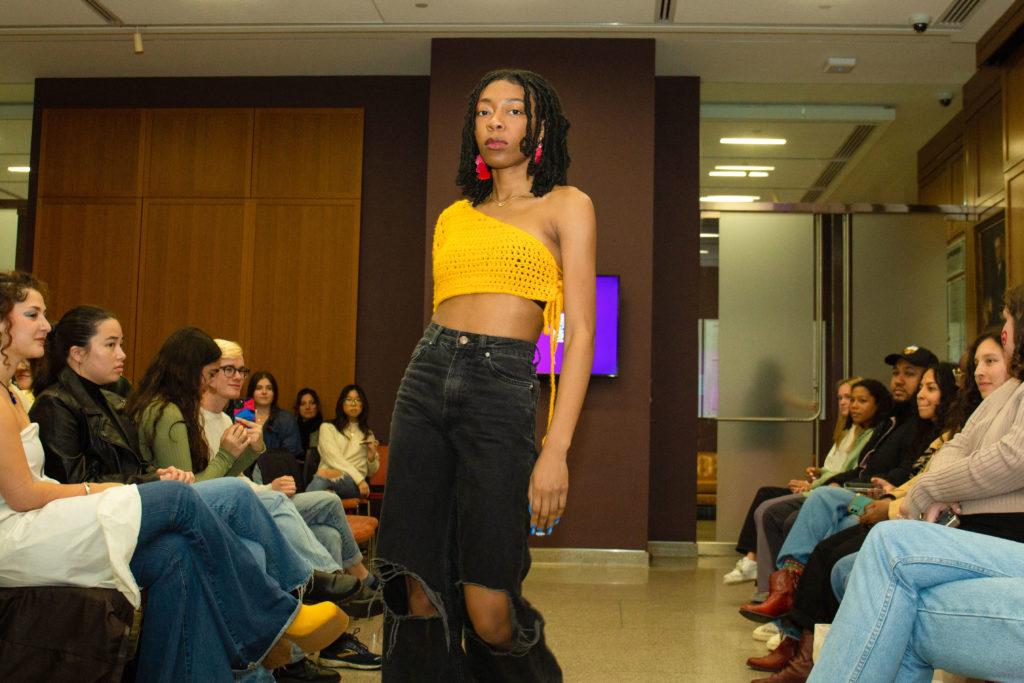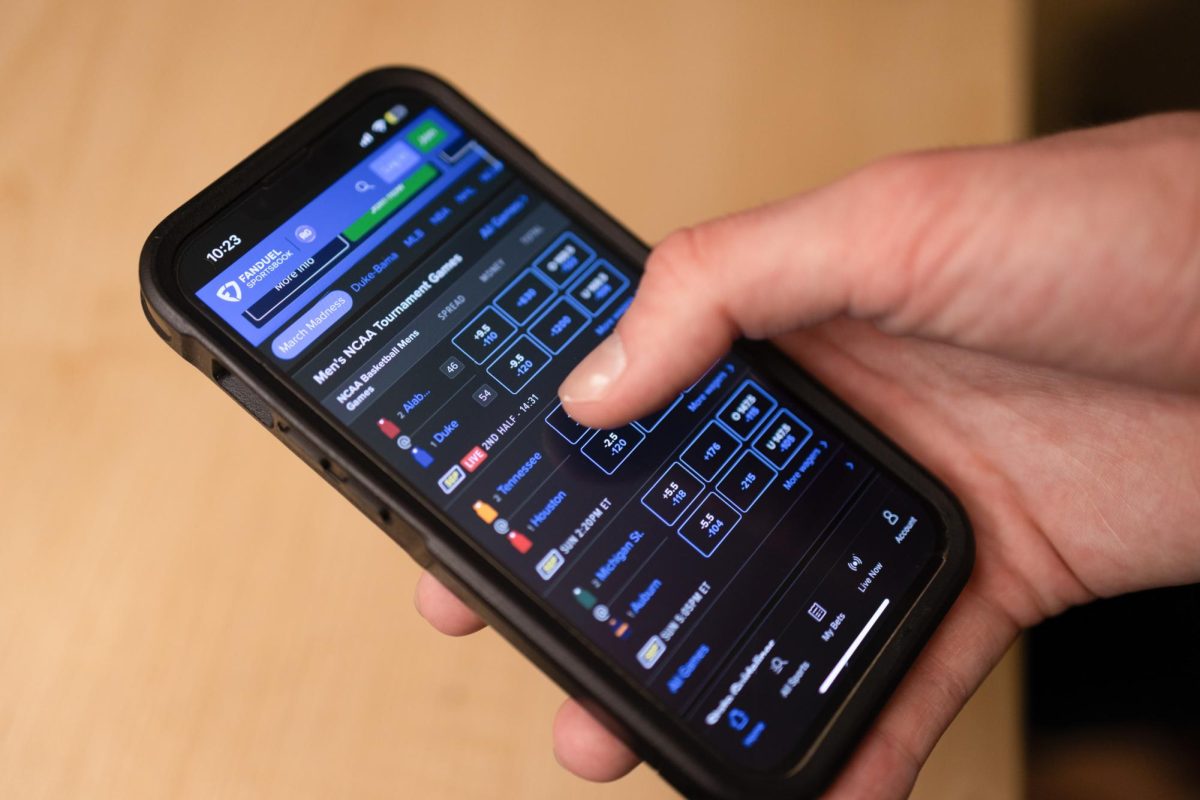For co-founder of GW Sustainable Fashion Ari Rivadeneira, fashion is an art, but the fast-paced industry process has corrupted this powerful form of expression.
A total of 19 student models walked the Sustainable Fashion Show runway wearing bright scarves, fashionable sunglasses and flashy pearl belts in GW Sustainable Fashion’s event at the GWU Textile Museum Friday. Rivadeneira said the event’s mission was to spread awareness about alternatives to the fast fashion brands whose unsustainable production practices harm the environment.
[gwh_image id=”1188920″ credit=”Rachel Schwartz | Assistant Photo Editor” size=”post-thumbnail” align=”center” /]
“We only have one world and we can’t exploit it anymore,” Rivadeneira, a junior studying environmental science and sustainability, said. “I don’t really think there’s a need for fast fashion at all. We want to keep this world and respect it and have it for future generations.”
The club borrowed the models’ clothing from local clothing shops in the DMV, including Tribute Collective, Happy Flores Shop and Slowdown Market and took clothes from the closet of student designer London Skye Roberson, a co-founder of GW Sustainable Fashion.
“The point was to kind of show people that there’s a lot of local resources,” Rivadeneira said.
With planning for the show beginning in January, Rivadeneira said the event focused on promoting sustainable outfitting through upcycling, a form of purchasing secondhand items and hand-making clothing. Rivadeneira said the broad theme of the collection, spring season, allowed them to find pieces with a variety of silhouettes, styles and colors — clothes that “you would wear on a sunny day” like bright skirts and accessories to match the moment like chic sunglasses.
On a rectangular runway surrounded by chairs, models showcased several pieces of handmade clothing on the corners of the stage, including a vibrant lime-green knit matching crop top and mini skirt set courtesy of Roberson. Another model sported a pair of gradient yellow and red pants hand-painted with blue abstract scribbles from The Slum Studio, a Ghanaian brand that creates hand-printed textiles and designs from fabrics that are designated as rubbish in an attempt to ameliorate the textile waste problem Ghana is currently facing.
“A lot of the pieces are really thought out and were either made by hand or have taken a long time to produce, it’s not like a machine that just keeps on making the same garment,” Rivadeneira said.
Several models dressed in secondhand and vintage items including accessories like sunglasses and platform shoes. Rivadeneira said aside from the stylistic benefits of wearing vintage clothing, buying secondhand ensures clothes are able to live a longer life outside of a landfill.
[gwh_image id=”1188922″ credit=”Rachel Schwartz | Assistant Photo Editor” size=”post-thumbnail” align=”center” /]
“Getting secondhand items, it’s like you’re taking a piece from a different decade that has a different story and putting it into your narrative and stuff,” Rivadeneira said. “I think it’s beautiful.”
Rivadeneira condemned microtrends and the tendency of people to purchase clothing that is momentarily the rage before it becomes outlandishly outdated, causing people to stop wearing the clothes and throw them away. She said clothing should instead be focused on “expressing yourself” and finding pieces “to wear forever.”
“Just having pieces that fit you — literally fit you like are tailored for you, but also that just fit your personality — is so much more meaningful than just kind of following whatever trends and stuff are in the magazines like an hour ago,” Rivadeneira said.
The models were all students who auditioned and were selected to walk the runway — Rivadeneira said they wanted to accept everyone interested in modeling. Ruth Holliday, a member of Sustainable Fashion’s programming board, said the models were given creative freedom to pick out their own outfits, with hand-painted spring-colored pants and old shorts lined with eye-catching lace all through the event space.
After braving a torrential downpour, Holliday rocked the taupe rain boots she came in with on the runway. Holliday said she was nervous to model, completely avoiding eye contact with audience members as she walked the runway, but found the performance itself “exhilarating.”
Anabel Brentar, a junior majoring in economics, modeled an upcycled pair of shorts adorned with ruffles and embroidery, a big black T-shirt reading “Punk Revolution Now” and a chair around her waist with thin metal rings. Brentar said she was nervous to perform in front of an audience at first, but she was proud to be part of such an important initiative.
“People are buying what’s new and what’s next, but we can still have really cool clothes and killer outfits with things that have already been worn or just that are handmade,” Brentar said.
Reva Dalmia, a freshman majoring in international business, said she was excited to exercise her confidence on the runway and loved the feeling of “commanding the stage.”
“When it comes to modeling or doing fashion shows, you really need to learn to be comfortable in your own skin and with what you’re putting out there,” Dalmia said. “This is something that just helps me be more confident in myself.”
[gwh_image id=”1188923″ credit=”Rachel Schwartz | Assistant Photo Editor” size=”post-thumbnail” align=”center” /]
Dalmia said the show’s environment was welcoming and all the participants — models and organizers — were supportive as no one placed blame on each other, even when mistakes were made.
“It’s very low key,” Dalmia said. “If you mess up or if you do a pose that you didn’t want to do, no one’s gonna really judge you for it. Just being there surrounded by all my friends and the new friends that I made just put me in a really good environment.”
Dalmia said she is concerned with how fast trend cycles cause so many pieces of clothing to end up in landfills and she said it is important to raise awareness about various sustainable initiatives.
“More people are starting to realize that fashion, being one of the biggest contributors to environmental waste and those kinds of issues, it’s something that we really have to pay attention to,” Dalmia said.




